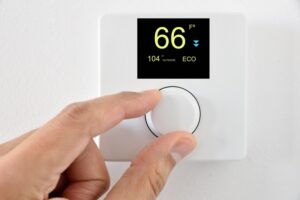 How high can you set your home’s thermostat? If your thermostat and heating system are like most, the upper setting is 90°F. That means, in theory at least, you could turn your house into a hot day at the beach even during the middle of winter. That probably doesn’t sound appealing to you, but a nice 80°F may sound ideal. You can lounge around in your shorts in perfect comfort. In January!
How high can you set your home’s thermostat? If your thermostat and heating system are like most, the upper setting is 90°F. That means, in theory at least, you could turn your house into a hot day at the beach even during the middle of winter. That probably doesn’t sound appealing to you, but a nice 80°F may sound ideal. You can lounge around in your shorts in perfect comfort. In January!
But … please don’t do this. Our recommendation for winter thermostat settings is to lower the thermostat, not raise it. As the temperature outdoors drops, you’ll feel tempted to push up the thermostat setting higher each time you feel too cold, and then lower it when it gets too hot, but this isn’t the best practice for energy costs and the performance of your heating system. We’ll explain more below.
A Thermostat Is Not a Gas Pedal
The more you push down on the gas pedal in a car, the more the engine works to make the car go faster. But the thermostat in your house does not work the same way. You don’t make the heating system create larger volumes of heat at a faster rate when you raise the thermostat setting. A thermostat is a switch. It turns the heating system on and turns it off. When you raise the temperature on the thermostat, you make the heater run for longer until it reaches the target temperature. You won’t get your heater to work any faster.
This is why we recommend keeping a steady setting on the thermostat. Find a temperature that is comfortable in your home and leave the thermostat set there. This will keep the heater from running more than necessary, which puts more strain on it and raises your bills, and you won’t end up with a house that keeps getting too hot.
Lower Temperature Settings Mean Slower Heat Loss
The lower thermostat setting we recommend during cold winter days is 68°F. This is ideal for helping to save energy and reduce the workload your heater must handle. It also helps your house to stay warmer for longer because it slows down heat loss. The closer in temperature the indoors is to the outdoors, the slower heat escapes from the house.
If you have the thermostat set up to 80°F, the heat will flee from the house rapidly and won’t do you much good. At 68°F, the heater will need to replace far less lost heat, contributing to lessening the strain on the heater and the cost to warm the house.
Lower the Thermostat More at Night
The 68°F recommendation is for the daytime when people are home. At night, or during times when the house is empty, we recommend lowering the setting by 8°F. (We don’t recommend ever setting the thermostat lower than 55°F during winter, even if you’re on vacation, since it will require far too much power to warm the house up again when you return. The cold can also damage parts of the house.)
If you have questions about your home heating and best practices, call us for the best in HVAC service in Athens, GA.
At Snellville Heating, Air and Plumbing, Your Comfort Is OUR Business. Rely on us for your heating needs this season.



